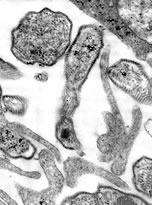Read and report vaccine reactions, harassment and failures.
Mumps Disease & Vaccine Information

Mumps virus is a contagious paramyxovirus that is comprised of a single-stranded RNA genome. Respiratory secretions transmit the virus and the infection begins in the nasopharynx and regional lymph nodes. After exposure, it generally takes 12 to 25 days for symptoms to develop. These symptoms typically include headache, muscle aches, tiredness, and loss of appetite. During this time, the virus is present in the blood and spreads throughout the body’s tissues. Parotitis, swelling of the parotid gland on one or both sides of the face under the ears and chin, is the most common clinical feature of a mumps infection, and typically occurs within the first two days. Up to 30 percent of people infected with mumps will have no symptoms of infection and up to 50 percent may exhibit signs of a mild nonspecific illness.
Mumps is generally a mild disease in childhood, but it can result in complications, which most often occur in adults. Complications of mumps include inflammation of the testicles in males, inflammation of the breast tissue and ovaries in females, meningitis, encephalitis, and loss of hearing. Fertility problems following mumps infection are rare. Mumps rarely results in death and most people recover from mump infection within a few weeks. Learn more about Mumps…
Mumps Vaccine
There are three mumps containing vaccines available for use in the United States. Two vaccines, MMRII and PRIORIX , are combination measles-mumps-rubella (MMR) live virus vaccines. The third, ProQuad is a combination measles-mumps-rubella-varicella (MMR-V) live virus vaccine. The CDC recommends that children receive two doses of a mumps containing vaccine, with the first dose between the ages 12-15 months, and the second dose between the ages 4-6 years. The CDC also recommends that individuals born after 1957 and that have no laboratory evidence of immunity or documentation of vaccination should receive at least one dose of MMR vaccine. Two doses of MMR vaccine are also recommended for healthcare personnel, students entering college and other post-high school educational institutions, as well as international travelers, if they have not already been vaccinated as a child.
The CDC also recommends MMR vaccination for infants between 6 and 12 months of age who may be traveling internationally. However, ProQuad, MMRII, and PRIORIX have only been approved for use in the U.S. for children older than 12 months of age. Learn more about Mumps vaccine…
Mumps Quick Facts
Mumps
- Mumps is a contagious viral infection and symptoms begin with a headache, muscle aches, tiredness, and loss of appetite . A stiff neck just before, during or after mumps infection is a sign that aseptic meningitis (inflammation of the lining of the brain) may have developed, which is a rare complication of mumps ;
- The typical “signature” physical sign of mumps is visible swelling of one or both sides of the face under the ears and chin. Males, who are past puberty, can experience pain and extreme swelling of the testes and rarely, become sterile. Mumps is very rarely fatal. Continue reading quick facts…
Mumps Vaccine
- There are three mumps containing vaccines available in the U.S. MMRII, manufactured by Merck, and PRIORIX, manufactured by GlaxoSmithKline, contain live attenuated measles, mumps, and rubella virus. ProQuad (MMR-V), also manufactured by Merck, contains live attenuated measles, mumps, rubella, and varicella virus. The CDC recommends that children get two doses of a mumps containing vaccine with the first dose given between ages 12-15 months, and the second dose given between ages 4-6 years;
- Common side effects from the MMR or MMR-V vaccine include low-grade fever, skin rash, itching, hives, swelling, reddening of skin, and weakness. Reported serious adverse reactions following MMR and MMR-V vaccination include seizures, brain inflammation and encephalopathy; thrombocytopenia; joint, muscle and nerve pain; gastrointestinal disorders; measles like rash; conjunctivitis and other serious health problems Continue reading quick facts...
NVIC encourages you to become fully informed about mumps and the mumps vaccine by reading all sections in the Table of Contents below, which contain many links and resources such as the manufacturer product information inserts, and to speak with one or more trusted health care professionals before making a vaccination decision for yourself or your child. This information is for educational purposes only and is not intended as medical advice.



